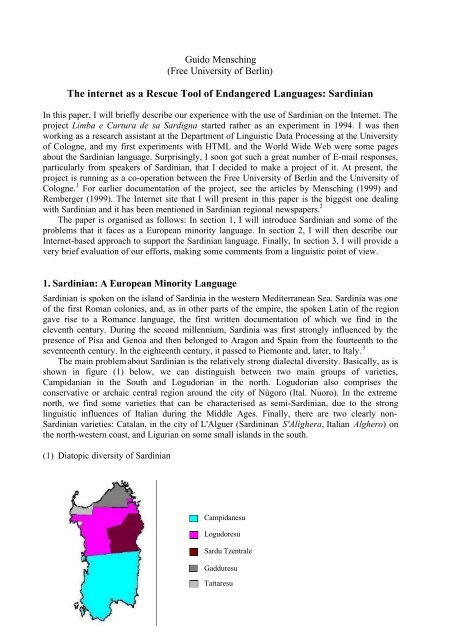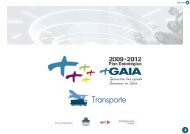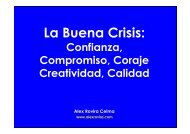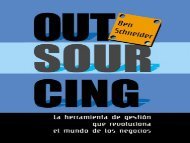The internet as a Rescue Tool of Endangered Languages ... - Gaia
The internet as a Rescue Tool of Endangered Languages ... - Gaia
The internet as a Rescue Tool of Endangered Languages ... - Gaia
Create successful ePaper yourself
Turn your PDF publications into a flip-book with our unique Google optimized e-Paper software.
Guido Mensching<br />
(Free University <strong>of</strong> Berlin)<br />
<strong>The</strong> <strong>internet</strong> <strong>as</strong> a <strong>Rescue</strong> <strong>Tool</strong> <strong>of</strong> <strong>Endangered</strong> <strong>Languages</strong>: Sardinian<br />
In this paper, I will briefly describe our experience with the use <strong>of</strong> Sardinian on the Internet. <strong>The</strong><br />
project Limba e Curtura de sa Sardigna started rather <strong>as</strong> an experiment in 1994. I w<strong>as</strong> then<br />
working <strong>as</strong> a research <strong>as</strong>sistant at the Department <strong>of</strong> Linguistic Data Processing at the University<br />
<strong>of</strong> Cologne, and my first experiments with HTML and the World Wide Web were some pages<br />
about the Sardinian language. Surprisingly, I soon got such a great number <strong>of</strong> E-mail responses,<br />
particularly from speakers <strong>of</strong> Sardinian, that I decided to make a project <strong>of</strong> it. At present, the<br />
project is running <strong>as</strong> a co-operation between the Free University <strong>of</strong> Berlin and the University <strong>of</strong><br />
Cologne. 1 For earlier documentation <strong>of</strong> the project, see the articles by Mensching (1999) and<br />
Remberger (1999). <strong>The</strong> Internet site that I will present in this paper is the biggest one dealing<br />
with Sardinian and it h<strong>as</strong> been mentioned in Sardinian regional newspapers. 2<br />
<strong>The</strong> paper is organised <strong>as</strong> follows: In section 1, I will introduce Sardinian and some <strong>of</strong> the<br />
problems that it faces <strong>as</strong> a European minority language. In section 2, I will then describe our<br />
Internet-b<strong>as</strong>ed approach to support the Sardinian language. Finally, In section 3, I will provide a<br />
very brief evaluation <strong>of</strong> our efforts, making some comments from a linguistic point <strong>of</strong> view.<br />
1. Sardinian: A European Minority Language<br />
Sardinian is spoken on the island <strong>of</strong> Sardinia in the western Mediterranean Sea. Sardinia w<strong>as</strong> one<br />
<strong>of</strong> the first Roman colonies, and, <strong>as</strong> in other parts <strong>of</strong> the empire, the spoken Latin <strong>of</strong> the region<br />
gave rise to a Romance language, the first written documentation <strong>of</strong> which we find in the<br />
eleventh century. During the second millennium, Sardinia w<strong>as</strong> first strongly influenced by the<br />
presence <strong>of</strong> Pisa and Genoa and then belonged to Aragon and Spain from the fourteenth to the<br />
seventeenth century. In the eighteenth century, it p<strong>as</strong>sed to Piemonte and, later, to Italy. 3<br />
<strong>The</strong> main problem about Sardinian is the relatively strong dialectal diversity. B<strong>as</strong>ically, <strong>as</strong> is<br />
shown in figure (1) below, we can distinguish between two main groups <strong>of</strong> varieties,<br />
Campidanian in the South and Logudorian in the north. Logudorian also comprises the<br />
conservative or archaic central region around the city <strong>of</strong> Nùgoro (Ital. Nuoro). In the extreme<br />
north, we find some varieties that can be characterised <strong>as</strong> semi-Sardinian, due to the strong<br />
linguistic influences <strong>of</strong> Italian during the Middle Ages. Finally, there are two clearly non-<br />
Sardinian varieties: Catalan, in the city <strong>of</strong> L'Alguer (Sardininan S'Alighera, Italian Alghero) on<br />
the north-western co<strong>as</strong>t, and Ligurian on some small islands in the south.<br />
(1) Diatopic diversity <strong>of</strong> Sardinian<br />
Campidanesu<br />
Logudoresu<br />
Sardu Tzentrale<br />
Gadduresu<br />
Tattaresu
I shall now turn to some linguistic properties, first from a historical perspective. It is a<br />
longstanding tradition within Romance Philology to characterise Sardinian <strong>as</strong> the most archaic<br />
Romance language, that is to say, the language that h<strong>as</strong> best conserved some Latin elements. I<br />
shall briefly mention some <strong>of</strong> these characteristics. Consider the following examples:<br />
(2) Some <strong>of</strong> the so-called archaic elements <strong>of</strong> Sardinian<br />
DOMVS > domo not: c<strong>as</strong>a<br />
MAGNVS > mannu not: grande<br />
PILVM > pilu not: pelo<br />
CANTAT > cantat not: canta_<br />
'house'<br />
'big'<br />
'hair'<br />
'he/she sings'<br />
First, there is the conservation <strong>of</strong> some words that have been lost in all other Romance<br />
languages, like the noun domus or the adjective magnus. <strong>The</strong> words pilu and cantat show the<br />
preservation <strong>of</strong> the short Latin vowels I and U and the third person singular ending -T. Sardinian<br />
is interesting, too, from a synchronic, structural perspective. For example, in phonology, there is<br />
a peculiar copying-rule, which takes the l<strong>as</strong>t vowel <strong>of</strong> a word and copies it to the end into an<br />
empty segment (or pause): 4<br />
(3) <strong>The</strong> paragocic vowel and the underlying copy-rule<br />
cantat ['kantata]<br />
'he/she sings'<br />
bides<br />
'you see'<br />
['bidåzå]<br />
C V C V C V<br />
Sequence <strong>of</strong> vowels<br />
and consonants<br />
copy<br />
In syntax, we have similarly interesting movement rules that cannot be discussed here. 5<br />
<strong>The</strong> sociolinguistic status is that <strong>of</strong> a minority language before any legal establishment <strong>as</strong> a<br />
regional language. Sardinian is mainly spoken in the villages, in private life (both in the family<br />
or for non-<strong>of</strong>ficial contact within the village community). Italian is the main language in the<br />
cities, where<strong>as</strong> in the villages it is used for communication with strangers. In this respect, it is<br />
notable that Italian is also used to communicate with speakers <strong>of</strong> distant dialects <strong>of</strong> Sardinian.<br />
Italian is almost the only language used for <strong>of</strong>ficial purposes. According to data presented by<br />
EUROMOSAIC, there is a serious decline <strong>of</strong> language ability from one generation to the next: 6<br />
(4) Ability in Sardinian according to EUROMOSAIC<br />
Very good Quite good Little None NA<br />
Father 228,00 44,00 11,00 10,00 3,00<br />
Mother 224,00 44,00 13,00 14,00 1,00<br />
Brother 124,00 54 57 23 38<br />
Sister 108 43 51 24 70<br />
Mat GPs 248 16 3 18 11<br />
Pat GPs 246 18 4 12 16<br />
-2-
<strong>The</strong> authors describe this <strong>as</strong> follows: "Ability [...] h<strong>as</strong> declined from about 80% <strong>as</strong> 'very good' in<br />
the parental generation to less than 50% recording the same level <strong>of</strong> ability for their siblings. <strong>The</strong><br />
change is far more pronounced than for the preceding generation. It is clear that Sardinian is<br />
seriously endangered." For the status <strong>of</strong> Sardinian <strong>as</strong> an endangered language, see also the<br />
UNESCO Red Book on <strong>Endangered</strong> <strong>Languages</strong> (Salminen 1993).<br />
As for the legal status, the Italian government, for a long time, did not recognise Sardinian <strong>as</strong><br />
a language. This situation h<strong>as</strong> changed only recently, with the regional law <strong>of</strong> 1997 and, more<br />
crucially, the national law for the protection <strong>of</strong> historical linguistic minorities. This law also<br />
mentions Sardinian. 7 As far <strong>as</strong> the standardisation <strong>of</strong> Sardinian is concerned, it is evident that the<br />
dialectal diversity makes it extremely difficult to find a common standard. <strong>The</strong>re is a commission<br />
working on the subject, whose success is, however, unclear at the moment. L<strong>as</strong>tly, it should be<br />
mentioned that Sardinian is spoken by about 1,300,000 people and is thus among the fifteen<br />
European minority languages with more than one million speakers. 8<br />
2. Applying Internet Technology to Sardinian<br />
<strong>The</strong> website we have been constructing is called "Limba e Curtura de sa Sardigna", or, by its<br />
English title, Sardinian Language and Culture.<br />
(5) Extract from the project homepage<br />
<strong>The</strong> aims <strong>of</strong> the project are<br />
• to provide information about the Sardinian language<br />
• to serve <strong>as</strong> an international forum for discussing issues concerning the language<br />
• to collect linguistic data with the aid <strong>of</strong> the Sardinian speaking Internet community<br />
• to document the language and its texts<br />
• to archive and to analyse the linguistic data retrieved<br />
Ultimately, the Internet site serves to reinforce the linguistic consciousness <strong>of</strong> speakers and<br />
learners <strong>of</strong> the language. This goal is achieved, among others, by making Sardinian the language<br />
<strong>of</strong> the website itself and <strong>of</strong> the discussion forum.<br />
Let us look at these individual points one by one. First is the <strong>as</strong>pect <strong>of</strong> information. <strong>The</strong> site<br />
<strong>of</strong>fers various starting points for getting acquainted with Sardinian and its properties. For<br />
example, there is a brief outline <strong>of</strong> the most important data from historical linguistics. <strong>The</strong>re is<br />
also a detailed linguistic map, which is a clickable map (see figure 6): on clicking on a specific<br />
dialect area, the user gets information from the UNESCO Red Book on <strong>Endangered</strong> languages<br />
and other online manuals, like e.g. Ethnologue.<br />
-3-
(6) Clickable linguistic map <strong>of</strong> Sardinia<br />
�<br />
This example demonstrates our endeavour to use the information provided by other sites. Thus,<br />
another function not mentioned so far is to serve <strong>as</strong> a central node for accessing online<br />
information about the Sardinian language and the culture <strong>of</strong> the island. <strong>The</strong> links are<br />
continuously updated, and up to now we have collected about two hundred links. Although, at<br />
present, there is quite an amount <strong>of</strong> information about Sardinian on the Internet, it must be said<br />
that much <strong>of</strong> it h<strong>as</strong> been stimulated by our site, <strong>as</strong> we could confirm by monitoring the web<br />
during the p<strong>as</strong>t years. A lot <strong>of</strong> information h<strong>as</strong> been gathered in collaboration with us. 9<br />
<strong>The</strong> next aim I would like to present is the discussion <strong>of</strong> Sardinian topics. This goal is<br />
achieved by the mailing list sa-limba ('the language'). <strong>The</strong> list w<strong>as</strong> founded in January 1999, and<br />
there are about 2500 messages up to now, so there is an average <strong>of</strong> 35 messages per week. At<br />
this moment, there are about 150 subscribers to the list. Around 90 percent <strong>of</strong> the participants are<br />
Sardinian, and most <strong>of</strong> them are located on the island itself. Of course, there are also Sardinian<br />
emigrants living all over the world. <strong>The</strong> most striking fact about this list is that the discussion is<br />
almost exclusively held in Sardinian. Note that nobody told the participants to do so. It rather<br />
seems a natural consequence <strong>of</strong> the use <strong>of</strong> E-mail; I will return to this point in section 3. Even<br />
more notably, there is a small number <strong>of</strong> foreigners who participate in the list and have learned<br />
Sardinian by means <strong>of</strong> their participation. Thus, the list definitely h<strong>as</strong> a didactic effect. But<br />
where<strong>as</strong> foreign learners are rather an exception, the didactic value applies particularly to the<br />
Sardinians themselves; because usually, in "non-virtual reality", hardly anybody writes in<br />
Sardinian. A typical situation is that a speaker presents himself to the list saying that this is the<br />
first time he is using Sardinian in a written form, adding some questions on how to spell certain<br />
sounds or words. Generally, the older members <strong>of</strong> the list (including some linguists) <strong>of</strong>fer their<br />
help, and normally this gives rise to some discussion about Sardinian orthography. Another<br />
effect is that the mailing list clearly contributes to the documentation <strong>of</strong> the Sardinian language,<br />
because all messages are archived; they can thus be considered a huge corpus <strong>of</strong> rather<br />
spontaneously produced written Sardinian, the first corpus <strong>of</strong> its kind. Recently, my research<br />
group at Berlin h<strong>as</strong> begun to evaluate the messages with respect to the various levels <strong>of</strong> the<br />
language system and its pragmatic use.<br />
-4-
In addition, the participants themselves started various interesting initiatives, for example,<br />
the translation <strong>of</strong> extracts from world literature into Sardinian. In (7) there is an example <strong>of</strong> a<br />
translation <strong>of</strong> Borges; but the members <strong>of</strong> our mailing list have also provided, for the first time,<br />
translations <strong>of</strong> works by Shakespeare or T.S. Eliot. Usually, the translations are reviewed by<br />
several other participants before they are archived on our website. Figure (8) shows an extract <strong>of</strong><br />
the work done up to now.<br />
(7) Translation <strong>of</strong> a poem by Borges, written by Nanni Falconi, one <strong>of</strong> the participants <strong>of</strong> sa-limba<br />
T'accumpazat muda sa luna<br />
(Lu mentovo male a Virgilio)<br />
finz<strong>as</strong> dae cando, induna notte perdida<br />
in su tempus, leados sos ojos tuos<br />
la idein de una 'ia<br />
indunu giardinu o colte de pioreddu.<br />
Pro sempre?<br />
Eo isco chi una die calecunu<br />
t'at a narrere in veridade:<br />
A bider pius non l'<strong>as</strong> custa luna cana,<br />
As finidu sa misura de su tempus<br />
ti t'at dadu su destinu<br />
D'ebad<strong>as</strong> chilchendela aberis<br />
tottu s<strong>as</strong> ventan<strong>as</strong> de su mundu.<br />
Est taldu. Non l'<strong>as</strong> agatare.<br />
Campamus iscobelzende e ismentighende<br />
su caldu serenu de sa notte.<br />
Bene la deves isperiare.<br />
Non siat s'ultima ch'ides.<br />
(8) Literary activities <strong>of</strong> sa-limba<br />
SA CIFRA LA CIFRA<br />
-5-<br />
La amistad silenciosa de la luna<br />
(cito mal a Virgilio) te acompana<br />
desde aquella perdida hoy en el tiempo<br />
noche o atardecer en que tus vagos<br />
ojos la descifraron para siempre<br />
en un jardin o un patio que so polvo.<br />
Para siempre?<br />
Yo sé que alguien, un dia,<br />
podra decirte verdaderamente:<br />
No volveràs a ver la clara luna.<br />
H<strong>as</strong> agotado ya la inalterable<br />
suma de veces que te da el destino.<br />
Inutil abrir todos l<strong>as</strong> ventan<strong>as</strong><br />
del mundo.<br />
Es tarde. No daràs con ella.<br />
Vivimos descubriendo y olvidando<br />
esa dulce costumbre de la noche.<br />
Hay que mirarla bien.<br />
Puede ser ùltima.<br />
With this, we have arrived at another aim <strong>of</strong> our website, namely the documentation <strong>of</strong><br />
Sardinian. What we really have here is linguistic data retrieval, that is that we usually do not use<br />
pre-existing documents but rather let the speakers themselves provide the documentation <strong>of</strong> their<br />
language. In this respect, the main part <strong>of</strong> our project is the Sardinian Text Datab<strong>as</strong>e (STD).<br />
Figure (9) shows a small extract <strong>of</strong> our collection. All texts are cl<strong>as</strong>sified according to the
linguistic varieties and are listed together with the names <strong>of</strong> the depositors. In (10) there is an<br />
example <strong>of</strong> a short Campidanian text (popular poetry from an oral source) in an HTML version,<br />
together with the standard indications according to the norms <strong>of</strong> the Sardinian Text Datab<strong>as</strong>e.<br />
Up to now, we have collected more than one hundred texts, some <strong>of</strong> them being whole books.<br />
For the future, we plan to use linguistic XML tagging, taking into account the TEI<br />
recommendations. 10<br />
(9) Extract from the Sardinian Text Datab<strong>as</strong>e<br />
Tìtulu<br />
Title<br />
-6-<br />
Bariedade<br />
Variety<br />
Depositore<br />
Depositor<br />
Poesia pro sa morte de unu frade (nobu!) Logudoresu Graziano Cortes<br />
Sos apostolos (nobu!) Sardu Tzentrale Mario Sanna<br />
Sa cont<strong>as</strong>cia de su b<strong>as</strong>olu (nobu!) Sardu Tzentrale Mario Sanna<br />
Unu contu de mannai mia (nobu!) Sardu Tzentrale Mario Sanna<br />
S'istoria de su prade e de sa perra de s'ava (nobu!) Sardu Tzentrale Mario Sanna<br />
Sa printzipessa e Sant'Anna (nobu!) Sardu Tzentrale Mario Sanna<br />
Su gravegliu de oro (nobu!) Sardu Tzentrale Mario Sanna<br />
S'orcu (nobu!) Nugoresu Mario Sanna<br />
Lu tempu Gadduresu Raffaele Ladu<br />
Acabada Logudoresu Michele Pio Ledda<br />
Carr<strong>as</strong>egare Logudoresu Giovanni Falconi<br />
Cathone Sarda de sa preistoria e Istoria de Sarule Logudoresu Raffaele Ladu<br />
Dae su trigu a su tzichi Logudoresu Gianfranco Unali<br />
Deus ti salvet Maria Logudoresu Raffaele Ladu<br />
Francesco Ignazio Mannu: Su Patriottu Sardu a sos Feudatarios Logudoresu Raffaele Ladu<br />
Francesco Ignazio Mannu: Una Biografìa Logudoresu Raffaele Ladu<br />
Gianfranco Coizza: Chentza tìtulu Logudoresu Gianfranco Coizza<br />
Gianfranco Coizza: Macchìghine Logudoresu Gianfranco Unali<br />
Gosos pro Santa Rita Logudoresu Raffaele Ladu<br />
Melchiorre Murenu: S<strong>as</strong> Ispurchìzi<strong>as</strong> de Bosa Logudoresu Raffaele Ladu<br />
Melchiorre Murenu: Una Biografìa Logudoresu Raffaele Ladu<br />
(10) Example <strong>of</strong> a short single text <strong>of</strong> the datab<strong>as</strong>e<br />
Title Fill<strong>as</strong><br />
Depositor Andria Salis <strong>as</strong>alis@vaxca1.unica.it<br />
Dialect Campidanesu ( Ceraxus - (CA))<br />
Source Anninnia Campidanesa intendia cantai in sa bidda de Ceraxus<br />
Copyright<br />
Comments<br />
HTML-Version Eva-Maria Remberger<br />
Duru duru (anninnia)<br />
E du duru duru e du duru dai<br />
chi custa pippia no si morjat mai<br />
mellus chi si morjat una vitelledda<br />
ca sa vitelledda si dd'eus a pappai<br />
e a chini a chini dd'eus a donai<br />
a unu a unu chi tenit dinai<br />
a unu a unu chi tenit muneda<br />
ca dd'at a bestiri de oru e de seda<br />
ca dd'at a portai a su baddu a baddai<br />
e du duru duru e du duru dai.
<strong>The</strong> next step is the evaluation <strong>of</strong> the linguistic data, that is the linguistic analysis and the<br />
description <strong>of</strong> Sardinian. What we are ultimately planning is to proceed from a purely manual<br />
processing to the automatic processing <strong>of</strong> linguistic data. At the moment, we use both manual<br />
and semi-automatic methods. I will give an example <strong>of</strong> each <strong>of</strong> them.<br />
An example <strong>of</strong> the manual analysis is a study we made about the particles <strong>of</strong> <strong>as</strong>sertion in<br />
Sardinian. 11 Already known w<strong>as</strong> the fact that you can say emmo, eja and si. However, the<br />
geographical distribution <strong>of</strong> these forms w<strong>as</strong> poorly understood. This is so, partly, because the<br />
Italian Linguistic Atl<strong>as</strong> (AIS) h<strong>as</strong> too few points to get an idea about the distribution <strong>of</strong> a<br />
linguistic phenomenon (see figure 11a). So we used our mailing list to do an online inquiry <strong>of</strong><br />
the speakers (11b). As a result, for the words at issue, the number <strong>of</strong> villages incre<strong>as</strong>ed<br />
considerably, <strong>as</strong> shown in (11c), where the black dots indicate the villages explored by means <strong>of</strong><br />
the mailing list. On the b<strong>as</strong>is <strong>of</strong> the higher density <strong>of</strong> points, we were then able to establish a<br />
hypothesis about the distribution <strong>of</strong> the words we are examining, at le<strong>as</strong>t in the northern part <strong>of</strong><br />
the island. As can be seen by comparing the map in (11d) to the one in (1) above, the are<strong>as</strong><br />
correspond more or less, but not exactly, to dialect boundaries.<br />
(11) Manual evaluation <strong>of</strong> linguistic online information (linguistic geography)<br />
a. Villages explored by AIS b. Online inquiry <strong>of</strong> Sardinian speakers (extract)<br />
-7-<br />
• Deu emmu a nai: "immoi mi narais ca ei immoi de<br />
nou" o mellus "a candu narais ca ei i a candu narais<br />
ca nou".<br />
• "Ottora mi nades chi emmo, ottora mi nades chi<br />
nono" e in atter<strong>as</strong> maner<strong>as</strong> puru; "emmo...nono"<br />
pero' gia' est cussu ebbia.<br />
• In domo si faeddada un ammesturu de campidanesu<br />
e kab<strong>as</strong>susesu e narranta: immoin mi nar<strong>as</strong>a ka eia,<br />
immoin ka no.<br />
• Salutos a tottu sor de sa lista, in Bitzi s'ausat "embo"<br />
e vinz<strong>as</strong> "eja".<br />
• In Oroteddi nan: "como mi nades eya e appustis<br />
nono" e in Seddori nan: "mui mi narais ch'eya e ago'<br />
ca no".<br />
c. Villages added with the aid <strong>of</strong> sa-limba d. Hypothesis about the distribution
Evidently, this procedure could be automated, so <strong>as</strong> to establish an electronic linguistic Atl<strong>as</strong> <strong>of</strong><br />
Sardinia.<br />
Before coming to the brief final section <strong>of</strong> this paper, I shall give one example <strong>of</strong> the semiautomatic<br />
processing <strong>of</strong> our data. A simple but effective tool is a program that generates online<br />
concordances from the material contained in the Sardinian Text Datab<strong>as</strong>e. This tool is at the<br />
disposal <strong>of</strong> all users. <strong>The</strong> input is a word or substring, <strong>as</strong> the Sardinian word for 'house' in figure<br />
(12a). <strong>The</strong> query is sent to our server at the Free University <strong>of</strong> Berlin, where a Perl Program<br />
generates an HTML-document and returns it to the user (12b). <strong>The</strong> result is a key-word in<br />
context concordance <strong>of</strong> the word at issue, <strong>as</strong> shown in (12c).<br />
(12) Using client-server technology for building online-concordances<br />
a. INPUT b. PROCESSING<br />
c. OUTPUT<br />
-8-<br />
Client Server<br />
Search
I will now conclude with some brief linguistic comments and an informal evaluation <strong>of</strong> our<br />
Internet experience with Sardinian.<br />
3. Linguistic Background and Evaluation<br />
Why is the Internet an appropriate means for minority languages? Let me start with the following<br />
model devised by the Catalan scholar <strong>of</strong> sociolinguistis, Lluis Aracil (see figure 13): x is the<br />
minority language, where<strong>as</strong> v, w, and z are other languages outside the domain <strong>of</strong> the language at<br />
issue, like English, French or German. Usually, the information about the minority language is<br />
not p<strong>as</strong>sed directly to those languages, but rather by the mediation <strong>of</strong> a dominant language y (cf.<br />
Aracil (1983:181ff.) 12<br />
(13) <strong>The</strong> concept <strong>of</strong> interposició by Lluis Aracil<br />
a. b.<br />
<strong>The</strong> dominant language y is interposed between x and the other languages, and therefore Aracil<br />
calls this effect interposició. Now, the special point about the Internet is that everyone can<br />
communicate with everyone, so we can have a direct connection from everywhere with our<br />
minority language. Thus, in figure (13b), direct lines can be drawn between x and v, w, z,<br />
respectively. We can therefore say that the effect <strong>of</strong> interposition is unknown to the Internet. See<br />
Mensching (1999) for further discussion <strong>of</strong> this idea and other arguments related to the<br />
characteristics <strong>of</strong> the Internet.<br />
Another point that makes the Internet an appropriate means for minority languages is the<br />
well known orality effect: 13 E-mail communication is more similar to spoken language than to<br />
written language. Thus, Sardinian is usually not employed <strong>as</strong> a written language, but<br />
nevertheless it is widely used in the Internet. Instead <strong>of</strong> further analysis, I shall just quote a<br />
message sent to our mailing list by a Sardinian living in France:<br />
I have written to you before, but this is the first time I am trying to communicate in the<br />
Sardinian language. I am a bit <strong>as</strong>hamed because I have almost never spoken it. For me, it is<br />
difficult because it does not come to me naturally. <strong>The</strong>refore I will try to begin to write it in<br />
the way my ear h<strong>as</strong> always heard it (or the way I think to understand it); it surely will be with<br />
many Italianisms or other "prestiti" (?). Maybe with time I will make progress in<br />
understanding what you say and what they say in Sardinia. You will surely help me more<br />
than I can help you. But what I can do and have already begun to do is to make other people<br />
in various places sensible (here in France and in Sardinia). 14<br />
This is an extreme c<strong>as</strong>e <strong>of</strong> a speaker who did not even speak Sardinian before and now begins to<br />
write it.<br />
Other <strong>as</strong>pects come to mind if we look again at the traditional are<strong>as</strong> <strong>of</strong> use <strong>of</strong> Sardinian and<br />
Italian (see section 1), some <strong>of</strong> which are summarised in the following table:<br />
-9-
(14) Some traditional are<strong>as</strong> <strong>of</strong> language usage<br />
Sardinian<br />
• mainly in the villages<br />
• between family and friends<br />
• in the village community<br />
• in private life<br />
Italian<br />
• in the cities<br />
• with strangers<br />
• in <strong>of</strong>ficial life<br />
In the Internet, there is a notable shift in the use <strong>of</strong> Sardinian <strong>as</strong> compared to non-virtual<br />
communication. Note that none <strong>of</strong> the traditional uses <strong>of</strong> the language apply in our c<strong>as</strong>e. In<br />
particular, a very interesting point is the use <strong>of</strong> Sardinian for communication with people from<br />
outside: notably, on the Internet, the language is also used among speakers from very distant<br />
dialects, who seem to understand themselves perfectly, at le<strong>as</strong>t in writing. This contradicts the<br />
widespread opinion that Campidanian and Logudorian are mutually incomprehensible. Note that<br />
written inter-dialect-communication is demonstrated, on a large scale, for the first time in our<br />
mailing list. It would be interesting to investigate what this means for standardising the language<br />
and for common language-planning theories. <strong>The</strong> mixture <strong>of</strong> different orthographies does not<br />
seem to play any role for understanding in the <strong>internet</strong> environment.<br />
Finally, let us return to the title <strong>of</strong> my paper: <strong>The</strong> Internet <strong>as</strong> a <strong>Rescue</strong> <strong>Tool</strong> <strong>of</strong> <strong>Endangered</strong><br />
<strong>Languages</strong>. This should rather have been formulated with a question mark. Nevertheless, it<br />
seems to us that our project on Sardinian Language and Culture <strong>of</strong>fers some interesting<br />
perspectives for the future.<br />
References<br />
Bolognesi, Roberto (1998): <strong>The</strong> Phonology <strong>of</strong> Campidanian Sardinian. A Unitary Account <strong>of</strong> a<br />
Self-Organizing Structure, <strong>The</strong> Hague: Holland Academic Graphics.<br />
Grimaldi, Lucia/Mensching, Guido (forthcoming): "Emmo, eja, si: Bejahungspartikeln im<br />
Sardischen".<br />
Jones, Michael Allan (1993): Sardinian Syntax, London: Routledge.<br />
Mensching, Guido/Remberger, Eva (forthcoming): "Sardisch: Eine Sprachskizze", to appear in<br />
Moderne Sprachen.<br />
Mensching, Guido (1994): Einführung in die sardische Sprache, 2nd ed., Bonn: Romanistischer<br />
Verlag.<br />
Mensching, Guido (1999): "Lingue in pericolo e comunicazione globale: il sardo su Internet" in<br />
Bolognesi, R./Helsloot, K. (eds.): La lingua sarda. L'identità socioculturale della<br />
Sardegna nel prossimo millennio. Atti del Convegno di Quartu Sant'Elena 9-10 Maggio<br />
1997, Cagliari: Condaghes, 171-191.<br />
[See also http://www.lingrom.fu-berlin.de/sardu/articolo.html].<br />
Remberger, Eva (1999): "Sa-Limba: D<strong>as</strong> Sardische im Internet", in RRZK-Komp<strong>as</strong>s 82, 15-17.<br />
[See also http://www.lingrom.fu-berlin.de/sardu/articEva.html].<br />
Salminen, Tapani (1993): UNESCO Red Book on <strong>Endangered</strong> <strong>Languages</strong>: Europe,<br />
http://www.helsinki.fi/~t<strong>as</strong>almin/europe_index.html.<br />
Notes<br />
1. Free University <strong>of</strong> Berlin, Department <strong>of</strong> Romance Philology / University <strong>of</strong> Cologne, Department <strong>of</strong><br />
Linguistic Data Processing. I would like to express my thanks to Eva Maria Remberger (Cologne), who<br />
from 1997 to 2000 spent much <strong>of</strong> her spare time keeping the project alive while I w<strong>as</strong> occupied with other<br />
-10-
t<strong>as</strong>ks. I also thank her for planning my participation at the Multilinguae Congress. <strong>The</strong> URL <strong>of</strong> the<br />
project's homepage is http://www.lingrom.fu-berlin.de/sardu.<br />
2. For some recent references to our Internet site see the following newspaper articles:<br />
Sanna, Ignazio: "Da Colonia (Germania) lingua sarda online" in Avvenimenti, May, 14 th 2000;<br />
"La lingua sarda protetta dai tedeschi" in L'Unione Sarda, October 9 th , 2000;<br />
Puddu, Renata: "Franc<strong>of</strong>orte: est arribau su ditzionariu nostu" in L'Obiettivo (Quartu), October 25 th , 2000.<br />
3. A brief sketch <strong>of</strong> the history <strong>of</strong> the Sardinian language, b<strong>as</strong>ed upon the introduction <strong>of</strong> Mensching<br />
(1994), can be found at http://www.lingrom.fu-berlin.de/sardu/auessere.html.<br />
4. For the phonology <strong>of</strong> Sardinian, see Bolognesi (1998). <strong>The</strong> rule is reflected quite well in Sardinian Email<br />
texts; see the example mentioned in note 14, e.g. este, enidi, ada, nadese from est, (b)enit, at, nades.<br />
5. See Jones (1993) and Mensching/Remberger (forthcoming).<br />
6. See http://www.uoc.es/euromosaic/web/homect/index2.html.<br />
7. Legge Regionale 15 ottobre 1997, n. 26: Promozione e valorizzazione della cultura e della lingua della<br />
Sardegna [http://www.regione.sardegna.it/ital/lg_biling.htm]. / Legge 15 dicembre 1999, n. 482: Norme<br />
in materia di tutela delle minoranze linguistiche storiche [http://www.senato.it/parlam/leggi/99482l.htm].<br />
See article 2: "In attuazione dell'articolo 6 della Costituzione e in armonia con i princípi generali stabiliti<br />
dagli organismi europei e internazionali, la Repubblica tutela la lingua e la cultura delle popolazioni<br />
albanesi, catalane, germaniche, greche, slovene e croate e di quelle parlanti il francese, il francoprovenzale,<br />
il friulano, il ladino, l'occitano e il sardo."<br />
8. See <strong>The</strong> Written <strong>Languages</strong> <strong>of</strong> the World: A Survey <strong>of</strong> the Degree and Modes <strong>of</strong> Use, Volume 3:<br />
Western Europe. Direction: Heinz Kloss and Grant D. McConnell.<br />
[http://www.ciral.ulaval.ca/geo/LEM3_IntroA1.html]<br />
9. An example are the data provided by a site called Geonative [http://www.geocities.com/geonative],<br />
located in the B<strong>as</strong>que country. It is a collection <strong>of</strong> placenames <strong>of</strong> different minority languages. <strong>The</strong><br />
Sardinian part w<strong>as</strong> made in cooperation with us.<br />
10. TEI: Text Encoding Initiative, see http://www-tei.uic.edu/orgs/tei/.<br />
11. <strong>The</strong> study w<strong>as</strong> made by Lucia Grimaldi (Berlin). See Grimaldi/Mensching (forthcoming).<br />
12. Aracil, Lluís (1983): Dir la realitat. Barcellona: Edicions Paúsos Catalans. See also Calaforra,<br />
Guillem (1999): La sociolingüística segons Lluís V. Aracil" in Kailuweit, R./Radatz, H.-I. (eds.):<br />
Katalanisch: Sprachwissenschaft und Sprachkultur. Akten des 14. Deutschen Katalanistentags im<br />
Rahmen von "Romania I". Jena, 28.9.-2.10.1997, Frankfurt: Vervuert, 73-99.<br />
13. See Mensching (1999) and the references mentioned there.<br />
14. Original text: "Bos appo già icrittu ma custa este sa prima olta ki proo a comunicare in limba salda, so<br />
unu pagu ilgonzosa ka no l'appo mancu mai faeddadu; pro a mie este diffizile ka non mi enidi<br />
naturalmente. Tando appo a proare cominzende a iscriere comente l'ada sempre intesu s'orija mia<br />
(ocomente pesso de lu cumprendere), i de siguru chin meda italianismos o atteros "prestiti" (?). Fossi a<br />
pianu a pianu appo a progredire e a cumprendere sempre menzus su chi nadese e su chi narran in Saldigna<br />
da ghi b'ando . De siguru m'azis a ajuare de piusu chi non eo a boisi, pero su chi potto faghere e chi appo<br />
cominzadu, este sensibilizzare atter<strong>as</strong> pesson<strong>as</strong> in divescios logos (inoghe in Franza e in Saldigna)."<br />
Message mailed to sa-limba@uni-koeln.de on February 8th, 1999.<br />
-11







